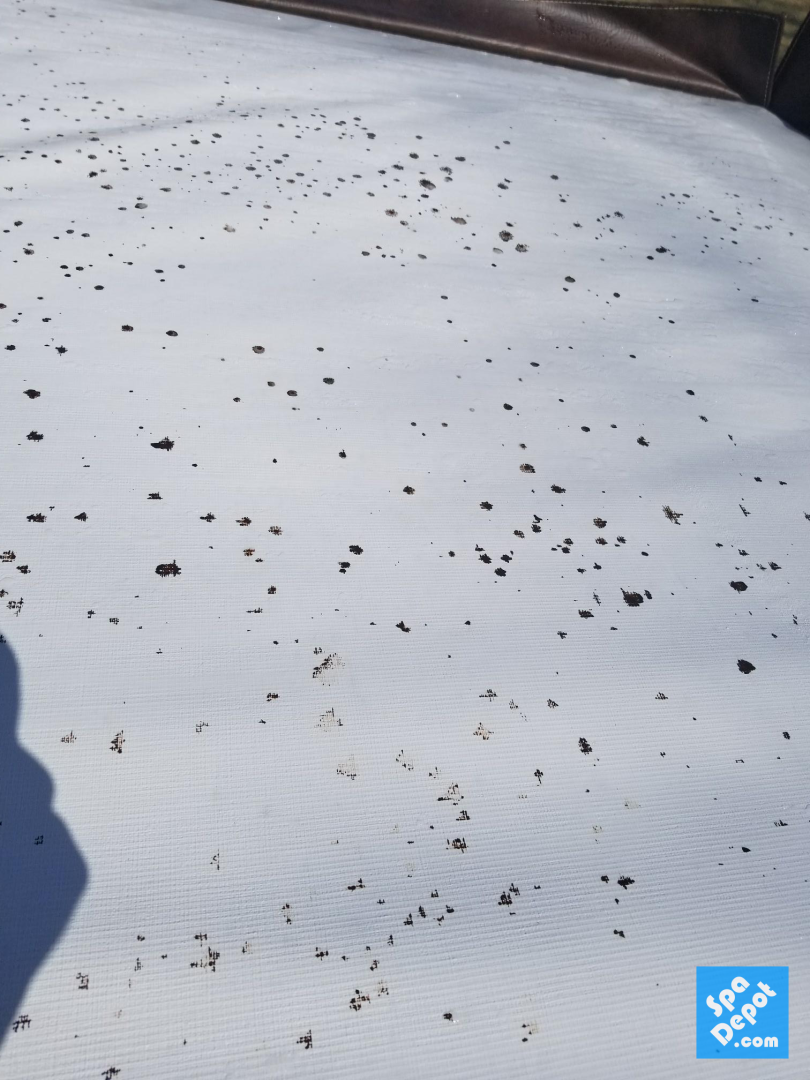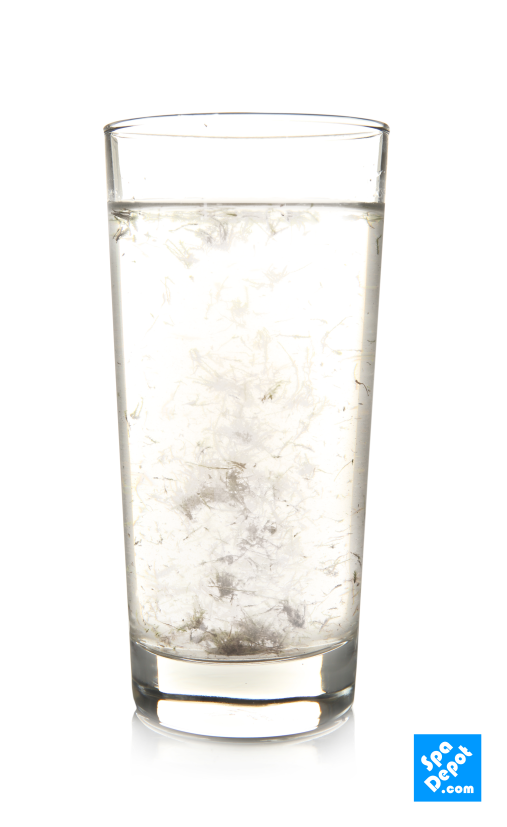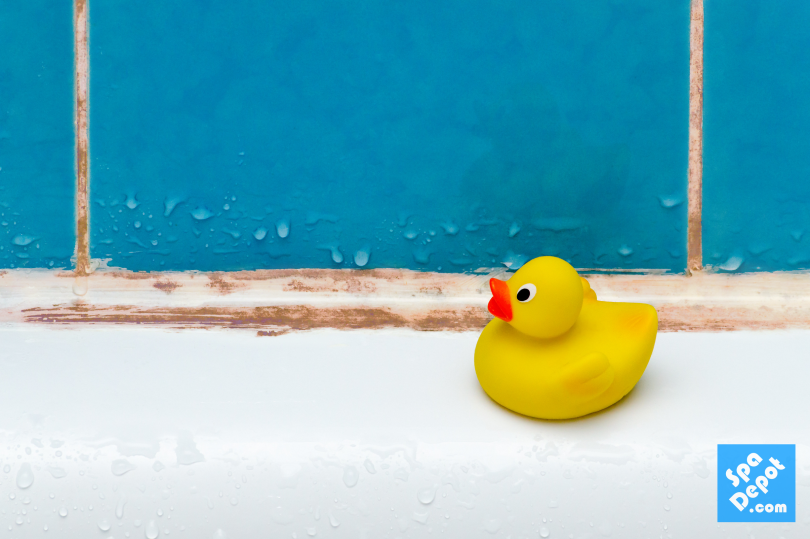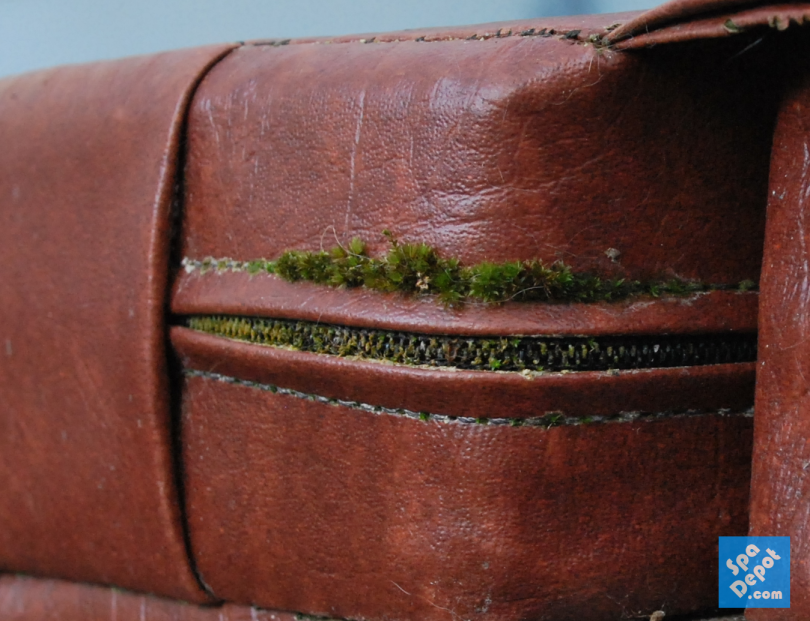Do you have black or white specks or pink colored film in your water?
Have you ever opened your spa cover and noticed a weird smell and saw foreign objects floating around in the water? The culprit could be mold. We’ll help you figure out the best way to tell if it is and what type of mold it is plus how to get rid of it.

Colors of Hot Tub Mold
- Black
- White
- Pink
Hot tubs are the perfect environment for mold to flourish, especially under the spa cover where they’re hot, humid and full of moisture. We have had many customers over the past 20 years contact us asking about the mold they found in their hot tub water or under the spa cover.
A typical hot tub can have over 100 feet of plumbing which feed into the many jets found in portable spas. With all of those nooks and crannies, microorganisms can hide and thrive. Routine water quality and cleaning maintenance can help prevent any mold growth.

Black mold in hot tubs is commonly found under your spa cover, on the headrests, or in any area that is above the water line, staying damp but not fully submerged. This is a fungus that can flake off and fall into the spa water and attach to the spa walls, making you think you have moldy water.

Where does black mold come from?
Black mold is caused by lack of water sanitation. It may not seem like water chemistry would make a huge difference on the spa cover, but it definitely does! If there is not enough sanitizer in your water, the mold spores are not destroyed, and the steam condenses onto the cover and headrests, finding dark, moist places to grow. You will begin to notice a funky smell when you open your spa and can find the culprit on or even inside the cover jacket.
If your hot tub cover has a zipper, take a look inside the vinyl jacket to see if more is living within the confines of the damp and dark spa cover. Read more on How to Properly Clean Your Hot Tub Cover.

Preventing Black Mold in Your Spa Cover
Once a month the dirt and grime should be cleaned off your spa cover to prevent any damage to the vinyl and chemical balancing issues. Using CleanAll and preserving it with 303 Protectant should keep your spa cover in better shape as well.
If you are going on vacation it is best to leave water in your spa. Before leaving drain and refill, but do not empty the hot tub! See How To Prep Your Hot Tub Before Vacation for sanitizer specific steps.

This type of mold appears in your hot tub as little white flakes or looks like shredded tissue paper floating in the water. Or, these white flakes could also be caused by calcium scale deposits.
How can you tell if it’s excess calcium or mold?
- Take a sample of the flakey water.
- Pour 20 drops of liquid bleach into the water sample, gently stir and wait 30 minutes.
- If flakes are still there, it’s more than likely calcium.
- If no flakes remain, it could be White Water Mold or biofilm.

White water mold is a fungus. It naturally grows in garden hoses, spa plumbing and moist, dark areas. By the time you notice it floating around your spa, it has definitely taken root within the plumbing.
White water mold is a result from biofilm, or a colony of bacteria mixed with dead skin cells, body oils, and beauty products. Biofilm builds up on the inside of the hot tub’s plumbing when bacteria is not being properly broken down by your hot tub disinfectant or from a poorly maintained spa.
When you don’t replace filters regularly, fail to test your spa water on a consistent basis or don’t use proper amounts of sanitizers, your hot tub becomes a breeding ground for these microbes. They build up in lower circulation areas when the spa is in use, and attach to surfaces when the pump is off.

White water mold is often accompanied by a pink slime or sludge; it’s mostly found encasing the filter and above the water line. It can also be found coating the plumbing within your hot tub.
Pink slime is something you may have seen before in a bathtub, toilet or sink. It’s a form of bacteria that builds up in the spa due to its perfect dark and moist conditions to breed microorganisms.

This bacteria is very resistant to chlorine, bromine and mineral sanitizers. Pink slime is not harmful, but is difficult to eradicate. It loves to hide in dark areas such as the plumbing within a spa.
Where Does Pink Slime Come From?
- Improper water maintenance. By not balancing the pH of your water, you may be doing a lot of harm to the spa equipment.
- Poor circulation. Biweekly filter rinses, quarterly filter deep cleans and annual filter replacement may help keep circulation up.
- Your water source. Water companies use mono-chloramines to treat the water that may not be as effective as first thought.
- Not allowing water to flow through the garden hose. Before filling up the spa, let the hose run for a couple minutes. (Pink slime loves living in the garden hose.)
Removing White Water Mold & Pink Slime
To remove White Water Mold and pink slime, start with the objects that go into your spa: skimmer net, floating spa blanket, chemical floater, floating thermostats, inflatable toys, brushes, water vacuums, etc. These items will need a deep clean with chlorine. If possible, replace your floating blanket.
The process to remove White Water Mold is labor intensive, yet very important follow each step to prevent the chance of the biofilm surviving all the following efforts of removal.
- Check pH balance and lower to 7.2.
- Remove and discard spa filter.
- Shock the spa with Dichlor granules; at least 8 teaspoons per 250 gallons. Let this high dose circulate for 1 hour.
- Next, add Oxy-Spa at 4 tablespoons per 250 gallons and allow to circulate for 1 hour.
- Prior to draining this chemically induced water, add Spa System Flush to super-clean the plumbing and every hidden crevice. Run pump and jets for a minimum of 2 hours, up to overnight.
- Step back and look at all the biofilm and other crud that has been loosened up by the Spa System Flush. Before you drain that dirty spa water, snap a picture! Once it’s all clean again, take another and we will feature your hot tub’s “before & after” shots on our Facebook page!
- Once empty, clean the spa shell, footwell, jet faces and any other exposed piece within the spa with CleanAll, a bucket of water and a damp cloth.
- Refill the hot tub.
- Before balancing water, add another high dose of dichlor, at least 8 teaspoons per 250 gallons. Allow this to circulate for a minimum of 2 hours without the cover on (Don’t forget the after picture!).
- Add your regular sanitizer.
White Water Mold, pink slime or biofilm is preventable by following the maintenance schedule listed below.
Moss
This type of plant is not a cause for immediate concern to the spa water chemistry as the other 3 types listed previously are. It can be found on the outside, top part of the vinyl spa cover.
Moss grows in damp and shady conditions. Steam from under the cover will vent, creating the damp situation moss needs to grow.

To remove moss on a hot tub cover, saturate it with CleanAll and allow to soak for 5 minutes. Then, using the rough side of a sponge gently scrub the moss off.
Remember to reapply 303 Vinyl Protectant after cleaning to increase your cover’s resistance to UV damage.

Keeping a sanitary spa should be a top priority for every hot tub owner. Without something to destroy bacteria, fungus, viruses and other microorganisms, hot tubs can get really unsafe, real quick. Even water that may look or smell ok runs the risk of making you sick if not properly sanitized.
There is so much confusion regarding the use of sanitizers and their effects on causing or preventing any of the aforementioned mold or bacterial issues.
An important note: No sanitizer can “cause” a mold problem.
Spores and bacterium exist in the air, in water and on surfaces, often harmlessly, until the opportunity arises for them to grow. Sufficient sanitizer destroys these microbes before they can grow. Any problems are usually a result from improper use of these sanitizers or disinfectants and balancing chemicals.
The Center for Disease Control only recommends a few sanitizers as proper hot tub disinfectants, or “Primary Sanitizers”. These include: chlorine, bromine and a few mineral sanitizers when used in combination with an oxidizer. Other products that do help destroy microorganisms but are not effective enough to use alone are “Secondary Sanitizers.”
UV is not a primary sanitizer.
Ozonators are not primary sanitizers.
Oxidizers aka non-chlorine shock or MPS are not primary sanitizers.
All of these can be noted as chemical reducing aids, but still require the use of a halogen based sanitizer.
While they may be considered a primary sanitizer when used with 30% hydrogen peroxide shock, Biagunides are not very effective sanitizers. Due to issues with slime mold and biofilm growth, we do not recommend any type of biguanides.
Contrary to popular belief, chlorine is still required in most ‘natural’ sanitizing systems. The Environmental Protection Agency does not approve any sanitizing system that doesn’t include some minimal amount of chlorine. Any product that claims to be chlorine-free is false advertising and should be avoided. However, it is important to remember that even chlorine could be considered “natural,” when it is made from saltwater and electricity!
Proper Maintenance
Having a routine maintenance schedule will make things easier for you and will help prevent mold from growing in the first place. You can print our Hot Tub Maintenance Schedule here.
Keeping your water balanced is only part of the equation. Your mold problem could be a result of not correctly cleaning or maintaining the hot tub cover. How to Properly Clean Your Hot Tub Cover.
